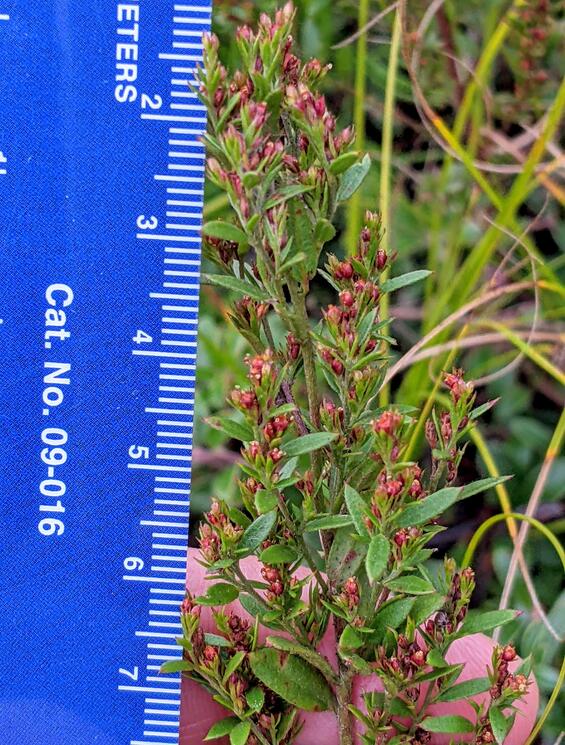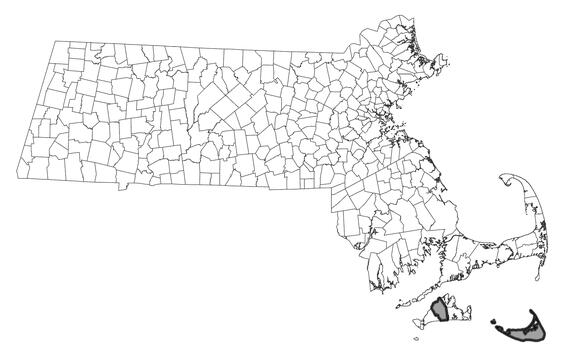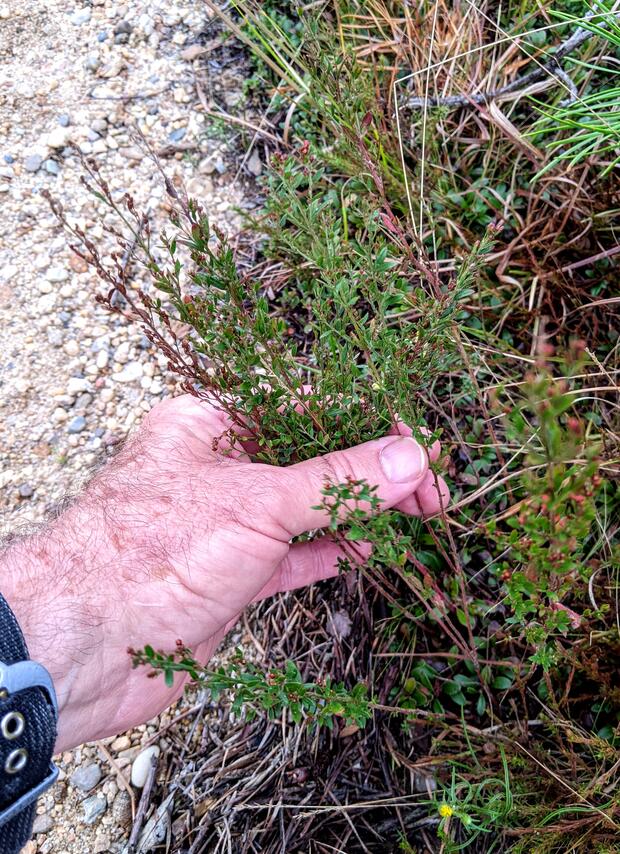- Scientific name: Lechea minor L.
- Species of Greatest Conservation Need (MA State Wildlife Action Plan)
Description

Thyme-leaf pinweed is a perennial herb to 50 cm (~20 in) tall with some leaves whorled and some alternate. The leaves are bright green, small, elliptic to lanceolate, 8-15 mm (0.3-0.6 in) long and 2-7 mm (0.08-0.3 in) wide, with entire, smooth margins, and sparse spreading hairs on midvein and edges. The late fall forming basal shoots are up to 5 cm (~2 in) long with leaves that are crowded, often opposite or whorled, more elliptic to egg-shaped, and only 3-6 mm (0.11-0.24 in) long. The fruiting structure is somewhat compact, finely leafy with ascending branches with clusters of stalked, reddish brown seed capsules. There are five sepals in two series, with outer two green, linear, much narrower, and quite a bit longer than the brownish, 1.6-2 mm (0.06-0.08 in) tall, broadly egg-shaped inner three. All five sepals are appressed-hairy. Seed capsules are up to 2 mm (0.08 in) long and 1.5 mm (0.06 in) wide, egg-shaped, almost enclosed by the persistent inner sepals, on pedicels shorter than 2 mm (0.08 in). The capsules are just about the same height as, or slightly taller than the sepals, so often the very top of the capsule is exposed above the sepal tips. There are two to three seeds per capsule. (Lemke 2020, The Field Museum 2009).
Thyme-leaf pinweed is a member of a genus Lechea with only six species in New England and Massachusetts. However, they have small and fine features, so identifying these plants takes expertise, a good hand lens or microscope, and a technical dichotomous key. Additionally, plants must be in the right stage of maturity to be accurately identified. The calyx on each flower is composed of five sepals in two distinct series. The two outer, bract-like sepals are slender and can be either longer or shorter than the three broader inner sepals and this is key to the variation between species. But the ratio of the length of the inner and outer sepals to the length of the seed capsule changes as the plants mature, adding an additional challenge to the correct identification. Beyond this is the fact that all species put out late season basal rosettes of leaves that overwinter, and these are often very helpful for identification, so the window of time to collect or identify these plants is smaller than for most others. The plants stigmas and anthers are extremely small and flower only for an hour or two in the early morning. Fortunately, flowers are not needed for identification.
All six of our pinweed species have the same basic look of a rather narrow, unbranched, straight upward main stem with either a slender or somewhat bushy flowering top. In winter, the plants dry in place retaining their upright posterior and most of the seed capsules. Lechea minor is the “type species” of the genus, meaning the species after which the genus is defined and named by Linnaeus in 1753 (Spaulding 2013).
Lechea minor is most similar to L. tenuifolia, except that species has very narrow (~1mm [0.04 in] wide) linear leaves on the main stem, and the outer sepals normally are just barely longer than the inner sepals. Lechea mucronata is also similar but that species has spreading hairs on the stem (not appressed, erect or ascending hairs [Spaulding 2013]).
Life cycle and behavior
Thyme-leaf pinweed is an herbaceous perennial.

Population status
Our database contains 13 records since 1985 of thyme-leaf pinweed with occurrences only in, Barnstable, Dukes and Nantucket Counties. iNaturalist shows 14 recent research-grade records from these same three counties (iNaturalist 2025). Previous it was also known from Bristol, Essex (1 record), Hampshire, Middlesex, Suffolk, and Plymouth County (Consortium of Northeastern Herbaria 2025). Massachusetts herbarium records show 87 specimen records with a legible date. Of those, only 11 occurred in the last 40 years (since 1985).
Distribution and abundance
Massachusetts is at the northeastern-most extent of the range of thyme-leaf pinweed which is known from all US states with land east of the Mississippi except New Hampshire and Maine (NatureServe 2025). It is state historic in Vermont and S1(extremely rare) in Rhode Island and is considered “apparently secure” in North Carolina, Mississippi and Florida (NatureServe 2025).

Distribution in Massachusetts. 1999-2024. Based on records in the Natural Heritage Database.
Habitat
Thyme-leaf pinweed is an herbaceous perennial in the rockrose (Cistaceae), family of plants that specialize in adaptions to hot dry conditions where wildfire can be frequent and that elsewhere are an important part of the Mediterranean chapparal. In New England, these plants occur on sandy glacial outwash plains where soil is droughty and nutrient poor. Their seeds are water impermeable, and that allows the seeds to retain long dormancies. Fire is the agent that will crack open the seeds and allow them to germinate (Luna et al. 2023, Pausas and Lamont 2022). Many studies also have researched the importance of various fungal species whose mycorrhrizal associations with this plant family assist in surviving droughty and impoverished soils (Caiafa et al. 2024).
In Massachusetts, it survives in dry, open habitats such as fire lanes in pitch pine, scrub oak habitat or sandplain grasslands. It occurs with warm season grasses and xeric specialists such as bear berry, little bluestem, post oak, scrub oak, sweet fern, flax-leaved aster, sickle-leaved golden-aster, and dwarf prairie willow.
Healthy habitats are vital for supporting native wildlife and plants. Explore habitats and learn about conservation and restoration in Massachusetts.
Threats
The primary threats are development, habitat succession and fire suppression.
Conservation
Much more survey work is needed to find more populations. One approach is to review old specimen data for locations and resurvey those sites to see if the plants might still be there. Surveys of known populations are needed to establish numbers and gather data on associated species, soil conditions and former or current management practices on all populations.
Management should consist of mowing where possible to control shrub and invasive species. Prescribed fire should be considered to maintain open habitat.
Acknowledgement
MassWildlife acknowledges the expertise of Margaret Curtin and Gregory Palermo whose field experience, iNaturalist posts, and teaching contributed substantially to the development of this fact sheet and the knowledge of this species.
References
Consortium of Northeastern Herbaria. 2025. Herbarium records.
https://portal.neherbaria.org/portal/collections/list.php. Accessed 1 April 2025
Cullina M, Connolly B, Sorrie B, Somers P (2011) The vascular plants of Massachusetts: a county checklist, 1st revision. Massachusetts Natural Heritage & Endangered Species Massachusetts Division of Fisheries and Wildlife, Westborough, MA
Gleason, Henry A., and Arthur Cronquist. Manual of Vascular Plants of Northeastern United States and Adjacent Canada, Second Edition. Bronx, NY: The New York Botanical Garden, 1991.
Haines A (2011) New England Wild Flower Society’s Flora Novae Angliae: a manual for the identification of native and naturalized higher vascular plants of New England. Yale University Press. 1008 pp.
iNaturalist 2025. Available from https://www.inaturalist.org. Accessed 1 April 2025
Lemke, David E. 2020. Lechea minor - FNA. Flora of North America North of Mexico [Online]. Website http://dev.floranorthamerica.org/Lechea_minor[accessed 2 April 2025]. Page version 30 July 2020. In: Flora of North America Editorial Committee, eds. 1993+. Flora of North America North of Mexico [Online]. 25+ vols. New York and Oxford. Vol. 9.
Luna, B., P. Piñas-Bonilla, G. Zavala, and B. Pérez. 2023. Timing of fire during summer determines seed germination in Mediterranean Cistaceae. Fire Ecology 19: 1–14.
NatureServe. 2025. NatureServe Network Biodiversity Location Data accessed through NatureServe Explorer [web application]. NatureServe, Arlington, Virginia. Available https://explorer.natureserve.org/. Accessed: 4/3/2025
Pausas, J. G., and B. B. Lamont. 2022. Fire-released seed dormancy - a global synthesis. Biological Reviews 97: 1612–1639.
Sampson, K., R. C. Evans, R. Browne, and A. K. Walker. 2024. In vitro micropropagation of critically imperiled Crocanthemum canadense (Cistaceae) and identification of endomycorrhizal symbionts. Plant Cell, Tissue and Organ Culture (PCTOC) 158: 1–11.
The Field Museum 2009. VPlants - Lechea minor. The vPlants Project. vPlants: A Virtual Herbarium of the Chicago Region. Website https://www.vplants.org/portal/taxa/index.php?tid=45142&taxauthid=1&clid=0 [accessed 3 April 2025].
Contact
| Date published: | April 30, 2025 |
|---|
